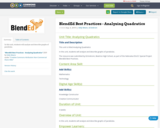
In this unit, students will analyze and describe graphs of parabolas.
- Subject:
- Education
- Mathematics
- Material Type:
- Activity/Lab
- Assessment
- Homework/Assignment
- Lesson
- Lesson Plan
- Teaching/Learning Strategy
- Unit of Study
- Date Added:
- 07/01/2019

In this unit, students will analyze and describe graphs of parabolas.
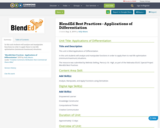
In this unit students will analyze and manipulate functions in order to apply them to real-life optimization (minimum/maximum) situations.
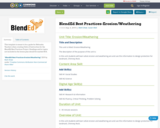
This template is meant to be a guide for Nebraska Teachers when creating Units of Instruction for the BlendEd Best Practices Project. Headings and/or topics not included in the lesson plan should be marked N/A.
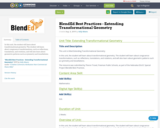
In this unit, the student will learn about transformational geometry. The student will learn about congruence transformations, such as reflections, translations, and rotations, and will also learn about geometric patterns
such as symmetry and tessellations.
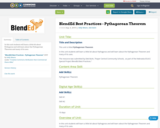
In this unit students will learn a little bit about Pythagoras and will learn about the Pythagorean Theorem and many of its uses.
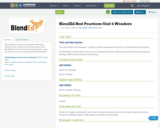
This template is meant to be a guide for Nebraska Teachers when creating Units of Instruction for the BlendEd Best Practices Project. Headings and/or topics not included in the lesson plan should be marked N/A.
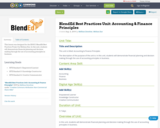
This lesson was designed for the ESUCC BlendEd Best Practices Project by Melissa Dux. In this unit, students will demonstrate financial planning and decision making through the use of accounting principles in business.
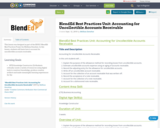
This lesson was designed as part of the ESUCC BlendEd Best Practices Project by Mellissa Donohoe. In this lesson, students will learn how to account for uncollectible accounts receivable.
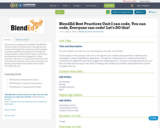
This lesson was designed for the ESUCC BlendEd Best Practices Project by Kristen Evans. Through this unit, students will expand their understand and knowledge of coding using different applications. Through this coding adventure, students will be able to understand how algorithms work when plugged into coding sequences. The basics of coding will be the focus of this unit, while also learning to read, write, and debug code. Reading and problem solving skills will be utilized throughout the unit.
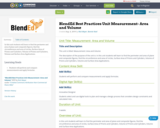
In this unit students will learn to find the perimeter and area of plane and composite figures, find the circumference and area of circles, Surface Area of Prisms and Cylinders, Volume of Prisms and Cylinders, Volume and Surface Area Applications.
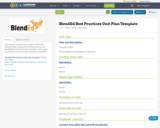
This template is meant to be a guide for Nebraska Teachers when creating Units of Instruction for the BlendEd Best Practices Project. Headings and/or topics not included in the lesson plan should be marked N/A.
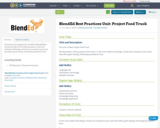
This lesson was designed for the ESUCC BlendEd Best Practices Project by Crys Bauermeister. In this unit students will design a food truck concept for your town that offers great tasting, interesting and diverse food.
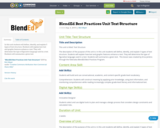
In this unit students will define, identify, and explain 5 types of text structure. Students will explain how text and graphic features enhance a text. They will determine the type of figurative language used in a text. Students will summarize a given text.
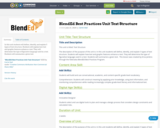
In this unit students will define, identify, and explain 5 types of text structure. Students will explain how text and graphic features enhance a text. They will determine the type of figurative language used in a text. Students will summarize a given text.
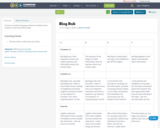
A rubric in student language written for middle school students to self-assess their blogs.
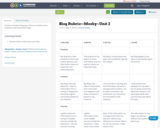
A rubric in student language written for middle school students to self-assess their blogs.
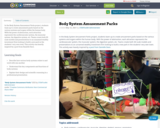
In the Body System Amusement Parks project, students team up to create amusement parks based on the various systems and organs within the human body. With the power of abstraction, each attraction represents the cardiovascular system, the muscular system, the digestive system, etc. Teams create both 3D scale models and presentations to an unnamed wealthy investment firm looking to build a new park in the students’ very own town. This activity was heavily inspired by a post from Danielle Dace.
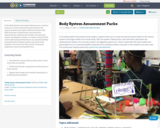
In the Body System Amusement Parks project, students team up to create amusement parks based on the various systems and organs within the human body. With the power of abstraction, each attraction represents the cardiovascular system, the muscular system, the digestive system, etc. Teams create both 3D scale models and presentations to an unnamed wealthy investment firm looking to build a new park in the students’ very own town. This activity was heavily inspired by a post from Danielle Dace.

In the Body System Amusement Parks project, students team up to create amusement parks based on the various systems and organs within the human body. With the power of abstraction, each attraction represents the cardiovascular system, the muscular system, the digestive system, etc. Teams create both 3D scale models and presentations to an unnamed wealthy investment firm looking to build a new park in the students’ very own town. This activity was heavily inspired by a post from Danielle Dace.

It is a helpful activity for using adjectives and body parts.